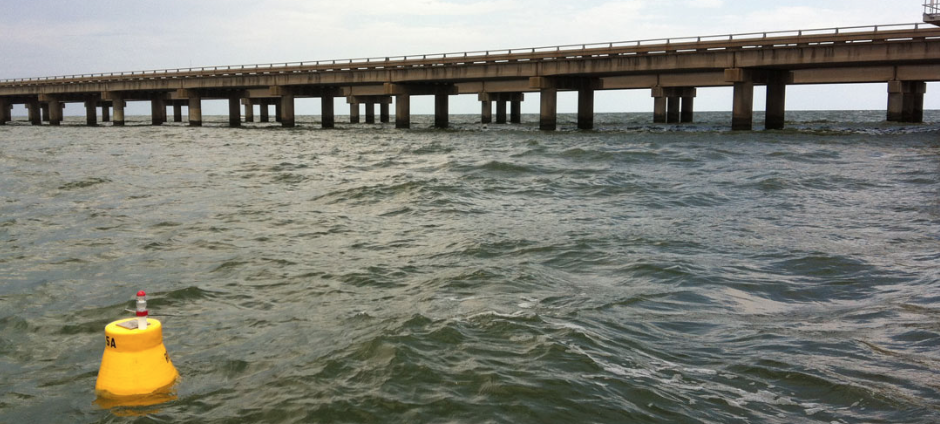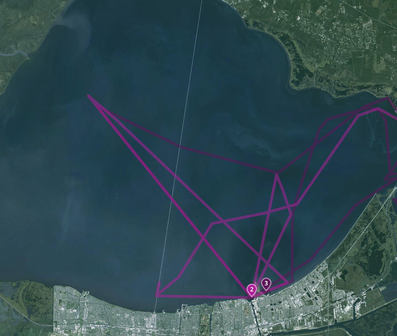 Keith Lusher
Keith Lusher The Louisiana Department of Wildlife and Fisheries has released it’s much anticipated results for the latest Lake Ponchartrain Radio Telemetry Study. The study has been ongoing for 4 years now and has help answer a lot of questions that pertain to speckled trout migration in Lake Pontchartrain. What makes this latest information so valuable is that it answers the question of what happens to the speckled trout in Lake Pontchartrain during and after the opening of Bonnet Carre’ Spillway.
Ashley Ferguson is a biologist with the LDWF and says before the spillway was opened they saw the majority of the speckled trout gathering in Industrial Canal. “Many of the speckled trout remained in the south eastern section of the Lake. After Christmas almost every single fish that we tagged was detected in the Inner Harbor Navigational Canal (Industrial Canal). So they went in and hunkered down for a while in there around Seabrook Marina,” Ferguson says. The spillway was opened on January 10, 2015 but before the Mississippi’s muddy water reached the Causeway, Ashely says the buoy at Lincoln Beach on the South Shore started showing trout moving into that area. “Around January 16th the trout began moving out of the Inner Harbor Navigational Canal and they were detected by Lincoln Beach. There’s a little seagrass bed that they where hanging out there,” she says. As the fresh muddy water from the river made it’s way east toward the Trestles, Ashley said they noticed that the trout were also pushed west proving the theory that the fish move along the line where water with salinity meets the fresh river water. “Almost two weeks after the opening of the spillway, as the water started moving further east, over 90% of the tagged fish were in the north eastern portion of Lake Pontchartrain. There was a high concentration of fish at the Lacombe Reef for about a week,” Ashely says.
Ashley Ferguson is a biologist with the LDWF and says before the spillway was opened they saw the majority of the speckled trout gathering in Industrial Canal. “Many of the speckled trout remained in the south eastern section of the Lake. After Christmas almost every single fish that we tagged was detected in the Inner Harbor Navigational Canal (Industrial Canal). So they went in and hunkered down for a while in there around Seabrook Marina,” Ferguson says. The spillway was opened on January 10, 2015 but before the Mississippi’s muddy water reached the Causeway, Ashely says the buoy at Lincoln Beach on the South Shore started showing trout moving into that area. “Around January 16th the trout began moving out of the Inner Harbor Navigational Canal and they were detected by Lincoln Beach. There’s a little seagrass bed that they where hanging out there,” she says. As the fresh muddy water from the river made it’s way east toward the Trestles, Ashley said they noticed that the trout were also pushed west proving the theory that the fish move along the line where water with salinity meets the fresh river water. “Almost two weeks after the opening of the spillway, as the water started moving further east, over 90% of the tagged fish were in the north eastern portion of Lake Pontchartrain. There was a high concentration of fish at the Lacombe Reef for about a week,” Ashely says.
 Louisiana Department of Wildlife and Fisheries Telemetry Buoy help put the puzzle together
Louisiana Department of Wildlife and Fisheries Telemetry Buoy help put the puzzle together The spillway was closed on February 1, 2016 and the lake started to see considerable improvement in water quality. Ashley says about one week after the spillway was closed, they noticed the fish making there way south. “One week after the spillway had closed the fish began to move back into the south and southwest portions of the lake. So they started using the lake like they naturally do,” Ferguson says. The Hydrocoast Map put out by the Lake Pontchartrain Basin Foundation is a tool that many anglers use for monitoring salinity conditions in Lake Pontchartrain. Ashley says she experimented with the path that the speckled trout traveled comparing it to the salinity readings from the map. “I overlaid the fish movements on the Hydrocoast Map and the fish were absolutely in the salinity.
 The Fish Tracking map at FishLa.org shows speckled trout gathering near the Industrial Canal before the muddy water hit
The Fish Tracking map at FishLa.org shows speckled trout gathering near the Industrial Canal before the muddy water hit They were in the water around one or two parts per thousand,” she says. There have been numerous discussions on whether or not speckled trout move out of the lake during the winter months and with the opening of the spillway in January, most anglers thought it was a forgone conclusion that the fish would abandon the lake. Ashley says, “We only detected one redfish that left through the Rigolets and one trout that left through Chef Pass But before the study ended, which was February 18th, both of those fish returned so they did not leave, they just avoided the plume of river water,” Ferguson says. Ashley adds that this years spillway opening was the earliest that we’ve seen and that future openings may not play out the same. “I can’t say that this is how they would behave in the future - if it was a spring opening or the water temperatures were a little different. A lot of times the fish can handle low salinity when the water temperatures are low. If those water temperatures were really high and the salinity was really low, it’s hard to say if they would remain in the lake or if they would leave,” She says. Anglers who are interested in the results of the study you can find it at www.fishla.org/fish-tracker/.




